Assessing the Impact of Staff Shortage on ICU Patient Centered Care
VerifiedAdded on 2021/01/02
|14
|3274
|136
Report
AI Summary
This report investigates the impact of staff shortages in Intensive Care Units (ICUs) on patient-centered care. It explores the background of the problem, highlighting challenges such as long working hours, low retention rates, and the impact on patient well-being, especially in critical care settings. The study aims to assess the effects of staff shortages, evaluate the effectiveness of patient-centered care, examine the consequences of staff shortages, and recommend strategies to improve nurse retention. The literature review examines the role of nurses in ICUs, the reasons for staff shortages, and the impact on patient care. The methodology includes exploratory research design, data collection through questionnaires, and random sampling of intensive care nurses. Ethical considerations, including confidentiality and data security, are addressed. The report emphasizes the need for understanding the impact of staff shortages and providing solutions for better patient care and nurse retention.
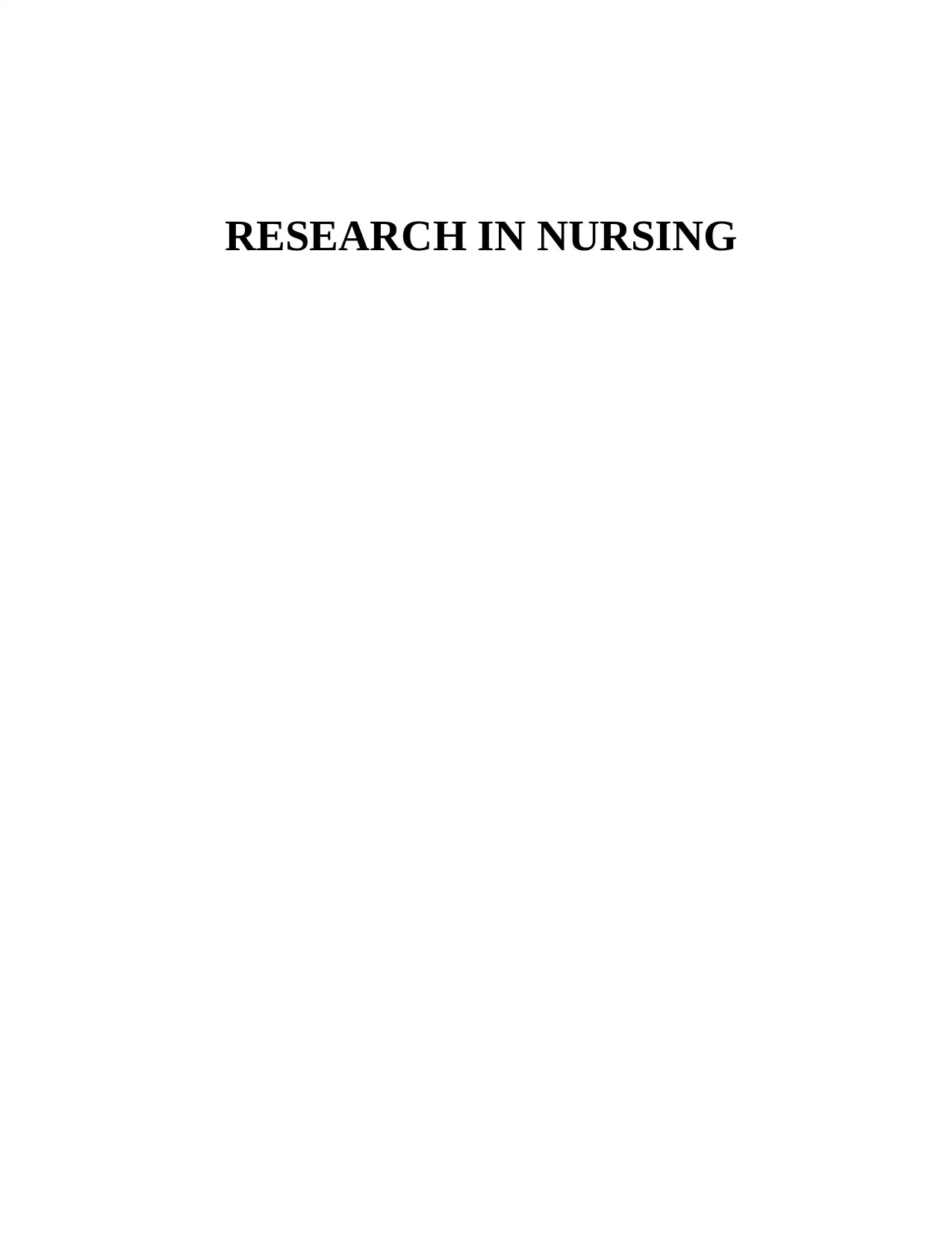
RESEARCH IN NURSING
Paraphrase This Document
Need a fresh take? Get an instant paraphrase of this document with our AI Paraphraser
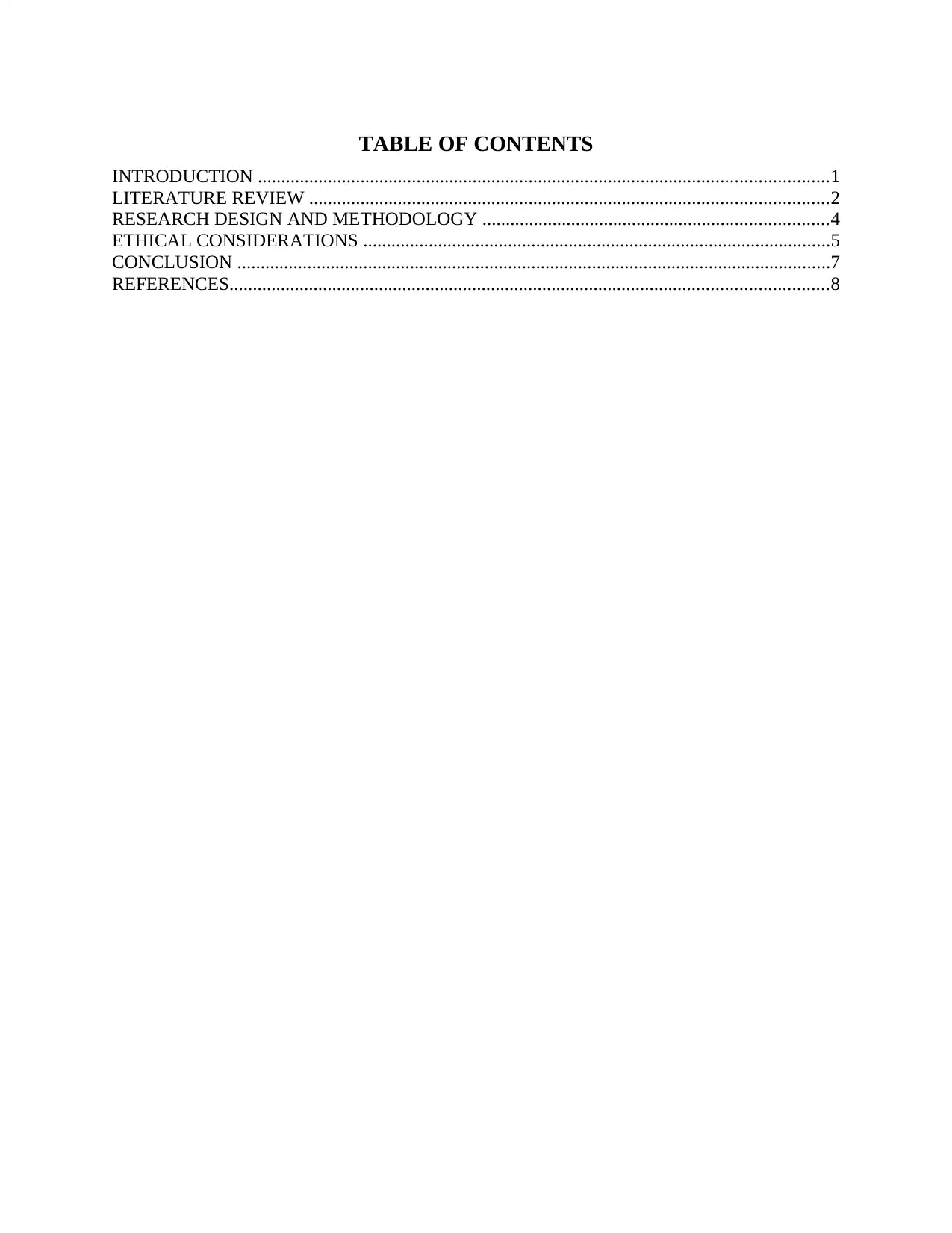
TABLE OF CONTENTS
INTRODUCTION ..........................................................................................................................1
LITERATURE REVIEW ...............................................................................................................2
RESEARCH DESIGN AND METHODOLOGY ..........................................................................4
ETHICAL CONSIDERATIONS ....................................................................................................5
CONCLUSION ...............................................................................................................................7
REFERENCES................................................................................................................................8
INTRODUCTION ..........................................................................................................................1
LITERATURE REVIEW ...............................................................................................................2
RESEARCH DESIGN AND METHODOLOGY ..........................................................................4
ETHICAL CONSIDERATIONS ....................................................................................................5
CONCLUSION ...............................................................................................................................7
REFERENCES................................................................................................................................8
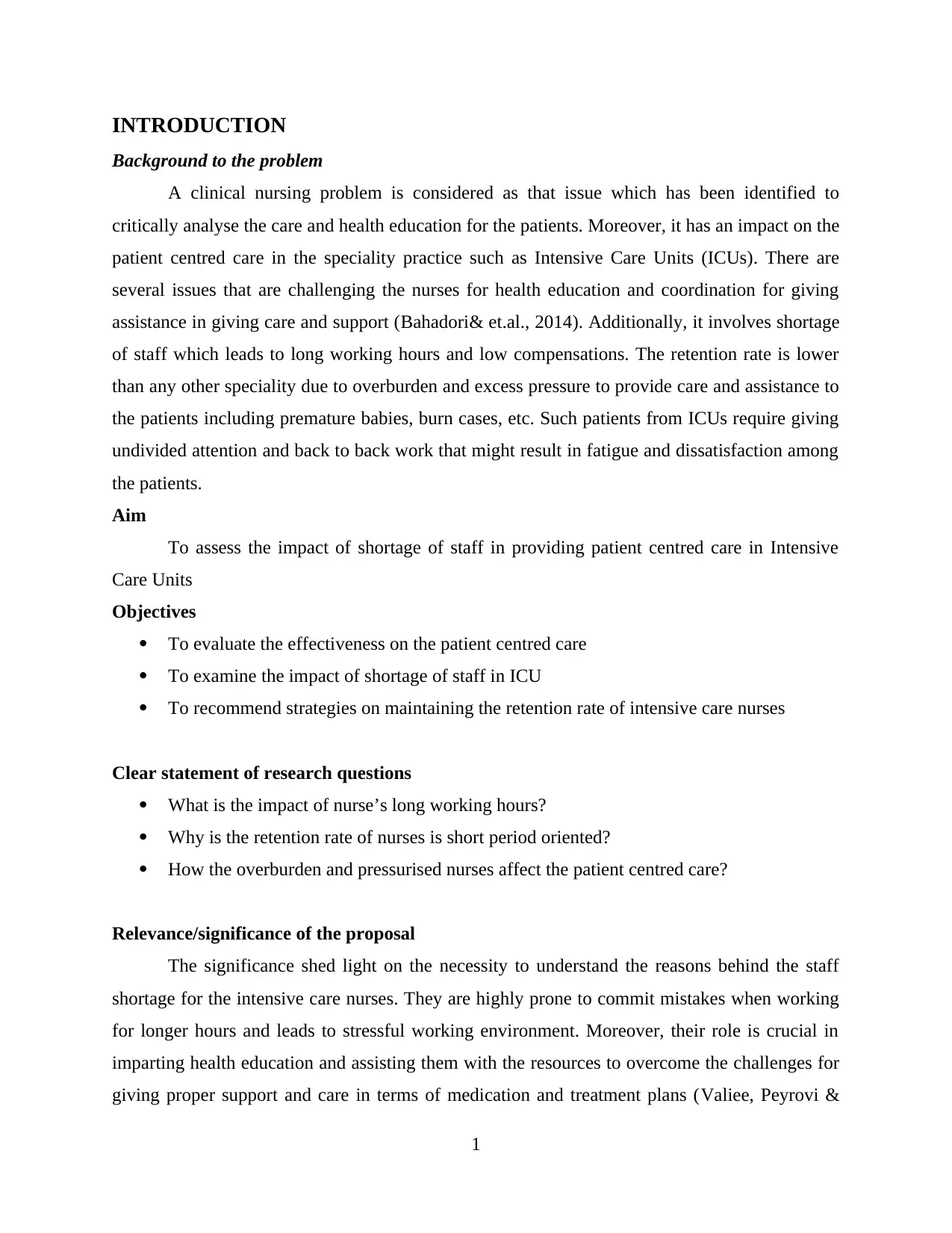
INTRODUCTION
Background to the problem
A clinical nursing problem is considered as that issue which has been identified to
critically analyse the care and health education for the patients. Moreover, it has an impact on the
patient centred care in the speciality practice such as Intensive Care Units (ICUs). There are
several issues that are challenging the nurses for health education and coordination for giving
assistance in giving care and support (Bahadori& et.al., 2014). Additionally, it involves shortage
of staff which leads to long working hours and low compensations. The retention rate is lower
than any other speciality due to overburden and excess pressure to provide care and assistance to
the patients including premature babies, burn cases, etc. Such patients from ICUs require giving
undivided attention and back to back work that might result in fatigue and dissatisfaction among
the patients.
Aim
To assess the impact of shortage of staff in providing patient centred care in Intensive
Care Units
Objectives
To evaluate the effectiveness on the patient centred care
To examine the impact of shortage of staff in ICU
To recommend strategies on maintaining the retention rate of intensive care nurses
Clear statement of research questions
What is the impact of nurse’s long working hours?
Why is the retention rate of nurses is short period oriented?
How the overburden and pressurised nurses affect the patient centred care?
Relevance/significance of the proposal
The significance shed light on the necessity to understand the reasons behind the staff
shortage for the intensive care nurses. They are highly prone to commit mistakes when working
for longer hours and leads to stressful working environment. Moreover, their role is crucial in
imparting health education and assisting them with the resources to overcome the challenges for
giving proper support and care in terms of medication and treatment plans (Valiee, Peyrovi &
1
Background to the problem
A clinical nursing problem is considered as that issue which has been identified to
critically analyse the care and health education for the patients. Moreover, it has an impact on the
patient centred care in the speciality practice such as Intensive Care Units (ICUs). There are
several issues that are challenging the nurses for health education and coordination for giving
assistance in giving care and support (Bahadori& et.al., 2014). Additionally, it involves shortage
of staff which leads to long working hours and low compensations. The retention rate is lower
than any other speciality due to overburden and excess pressure to provide care and assistance to
the patients including premature babies, burn cases, etc. Such patients from ICUs require giving
undivided attention and back to back work that might result in fatigue and dissatisfaction among
the patients.
Aim
To assess the impact of shortage of staff in providing patient centred care in Intensive
Care Units
Objectives
To evaluate the effectiveness on the patient centred care
To examine the impact of shortage of staff in ICU
To recommend strategies on maintaining the retention rate of intensive care nurses
Clear statement of research questions
What is the impact of nurse’s long working hours?
Why is the retention rate of nurses is short period oriented?
How the overburden and pressurised nurses affect the patient centred care?
Relevance/significance of the proposal
The significance shed light on the necessity to understand the reasons behind the staff
shortage for the intensive care nurses. They are highly prone to commit mistakes when working
for longer hours and leads to stressful working environment. Moreover, their role is crucial in
imparting health education and assisting them with the resources to overcome the challenges for
giving proper support and care in terms of medication and treatment plans (Valiee, Peyrovi &
1
⊘ This is a preview!⊘
Do you want full access?
Subscribe today to unlock all pages.

Trusted by 1+ million students worldwide
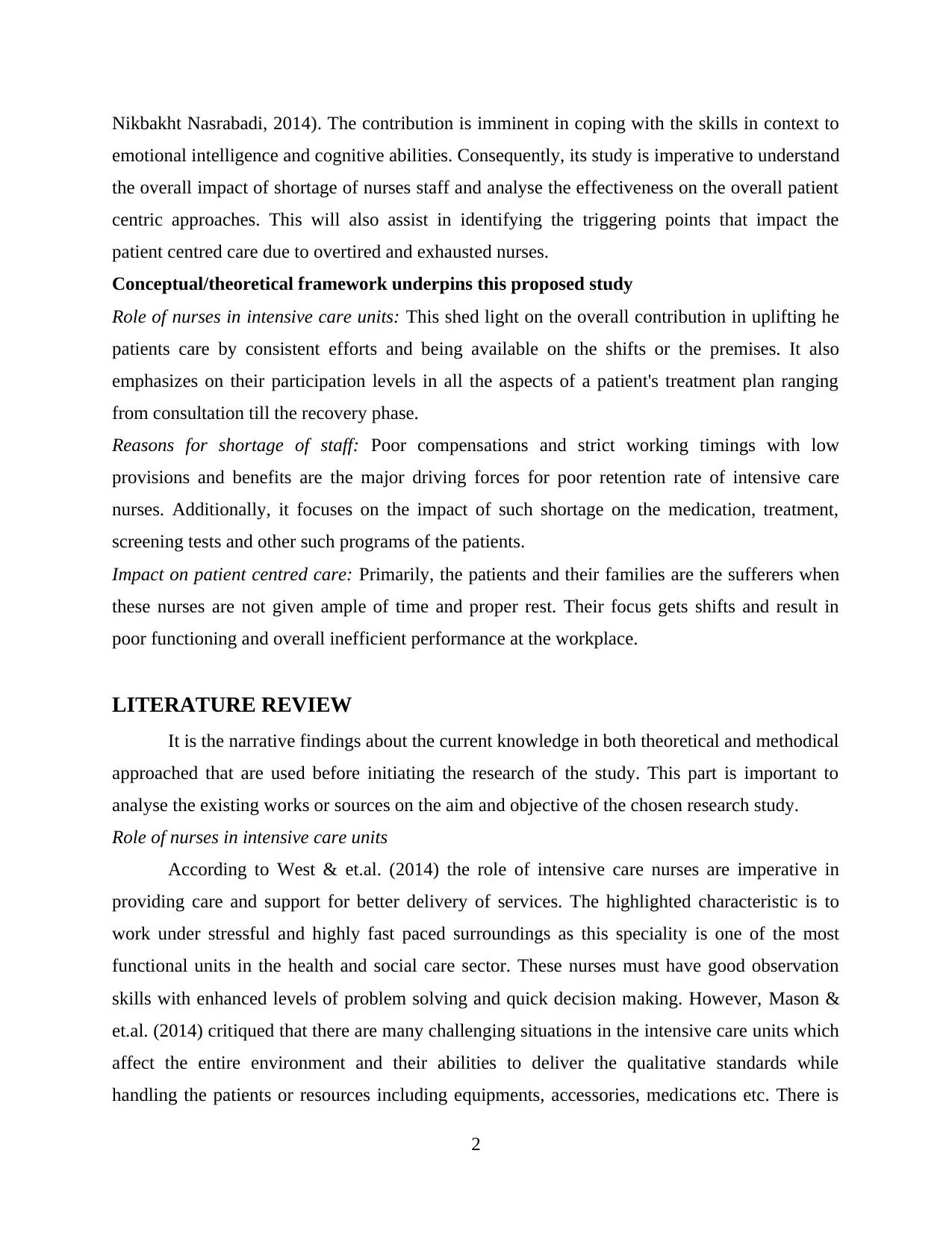
Nikbakht Nasrabadi, 2014). The contribution is imminent in coping with the skills in context to
emotional intelligence and cognitive abilities. Consequently, its study is imperative to understand
the overall impact of shortage of nurses staff and analyse the effectiveness on the overall patient
centric approaches. This will also assist in identifying the triggering points that impact the
patient centred care due to overtired and exhausted nurses.
Conceptual/theoretical framework underpins this proposed study
Role of nurses in intensive care units: This shed light on the overall contribution in uplifting he
patients care by consistent efforts and being available on the shifts or the premises. It also
emphasizes on their participation levels in all the aspects of a patient's treatment plan ranging
from consultation till the recovery phase.
Reasons for shortage of staff: Poor compensations and strict working timings with low
provisions and benefits are the major driving forces for poor retention rate of intensive care
nurses. Additionally, it focuses on the impact of such shortage on the medication, treatment,
screening tests and other such programs of the patients.
Impact on patient centred care: Primarily, the patients and their families are the sufferers when
these nurses are not given ample of time and proper rest. Their focus gets shifts and result in
poor functioning and overall inefficient performance at the workplace.
LITERATURE REVIEW
It is the narrative findings about the current knowledge in both theoretical and methodical
approached that are used before initiating the research of the study. This part is important to
analyse the existing works or sources on the aim and objective of the chosen research study.
Role of nurses in intensive care units
According to West & et.al. (2014) the role of intensive care nurses are imperative in
providing care and support for better delivery of services. The highlighted characteristic is to
work under stressful and highly fast paced surroundings as this speciality is one of the most
functional units in the health and social care sector. These nurses must have good observation
skills with enhanced levels of problem solving and quick decision making. However, Mason &
et.al. (2014) critiqued that there are many challenging situations in the intensive care units which
affect the entire environment and their abilities to deliver the qualitative standards while
handling the patients or resources including equipments, accessories, medications etc. There is
2
emotional intelligence and cognitive abilities. Consequently, its study is imperative to understand
the overall impact of shortage of nurses staff and analyse the effectiveness on the overall patient
centric approaches. This will also assist in identifying the triggering points that impact the
patient centred care due to overtired and exhausted nurses.
Conceptual/theoretical framework underpins this proposed study
Role of nurses in intensive care units: This shed light on the overall contribution in uplifting he
patients care by consistent efforts and being available on the shifts or the premises. It also
emphasizes on their participation levels in all the aspects of a patient's treatment plan ranging
from consultation till the recovery phase.
Reasons for shortage of staff: Poor compensations and strict working timings with low
provisions and benefits are the major driving forces for poor retention rate of intensive care
nurses. Additionally, it focuses on the impact of such shortage on the medication, treatment,
screening tests and other such programs of the patients.
Impact on patient centred care: Primarily, the patients and their families are the sufferers when
these nurses are not given ample of time and proper rest. Their focus gets shifts and result in
poor functioning and overall inefficient performance at the workplace.
LITERATURE REVIEW
It is the narrative findings about the current knowledge in both theoretical and methodical
approached that are used before initiating the research of the study. This part is important to
analyse the existing works or sources on the aim and objective of the chosen research study.
Role of nurses in intensive care units
According to West & et.al. (2014) the role of intensive care nurses are imperative in
providing care and support for better delivery of services. The highlighted characteristic is to
work under stressful and highly fast paced surroundings as this speciality is one of the most
functional units in the health and social care sector. These nurses must have good observation
skills with enhanced levels of problem solving and quick decision making. However, Mason &
et.al. (2014) critiqued that there are many challenging situations in the intensive care units which
affect the entire environment and their abilities to deliver the qualitative standards while
handling the patients or resources including equipments, accessories, medications etc. There is
2
Paraphrase This Document
Need a fresh take? Get an instant paraphrase of this document with our AI Paraphraser
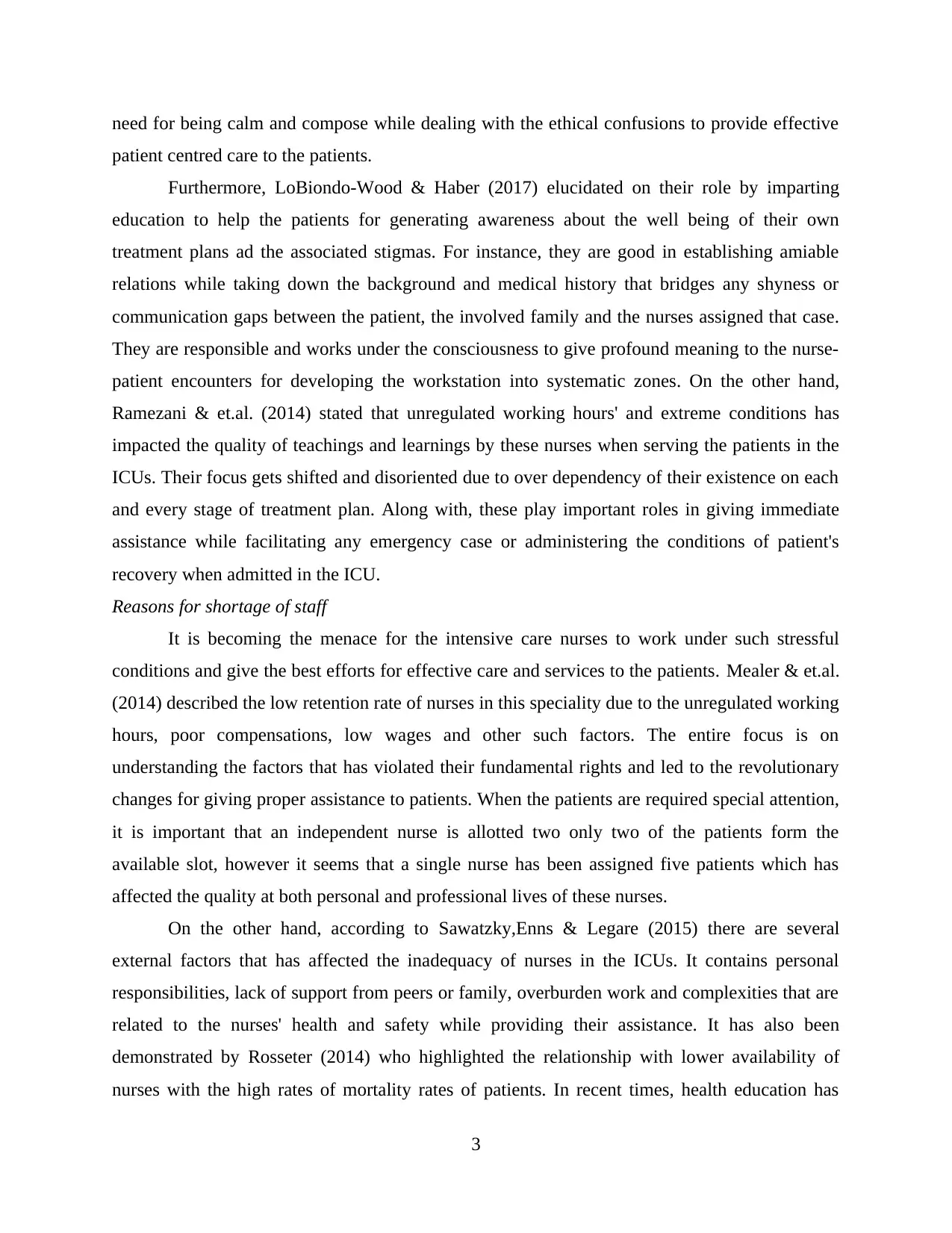
need for being calm and compose while dealing with the ethical confusions to provide effective
patient centred care to the patients.
Furthermore, LoBiondo-Wood & Haber (2017) elucidated on their role by imparting
education to help the patients for generating awareness about the well being of their own
treatment plans ad the associated stigmas. For instance, they are good in establishing amiable
relations while taking down the background and medical history that bridges any shyness or
communication gaps between the patient, the involved family and the nurses assigned that case.
They are responsible and works under the consciousness to give profound meaning to the nurse-
patient encounters for developing the workstation into systematic zones. On the other hand,
Ramezani & et.al. (2014) stated that unregulated working hours' and extreme conditions has
impacted the quality of teachings and learnings by these nurses when serving the patients in the
ICUs. Their focus gets shifted and disoriented due to over dependency of their existence on each
and every stage of treatment plan. Along with, these play important roles in giving immediate
assistance while facilitating any emergency case or administering the conditions of patient's
recovery when admitted in the ICU.
Reasons for shortage of staff
It is becoming the menace for the intensive care nurses to work under such stressful
conditions and give the best efforts for effective care and services to the patients. Mealer & et.al.
(2014) described the low retention rate of nurses in this speciality due to the unregulated working
hours, poor compensations, low wages and other such factors. The entire focus is on
understanding the factors that has violated their fundamental rights and led to the revolutionary
changes for giving proper assistance to patients. When the patients are required special attention,
it is important that an independent nurse is allotted two only two of the patients form the
available slot, however it seems that a single nurse has been assigned five patients which has
affected the quality at both personal and professional lives of these nurses.
On the other hand, according to Sawatzky,Enns & Legare (2015) there are several
external factors that has affected the inadequacy of nurses in the ICUs. It contains personal
responsibilities, lack of support from peers or family, overburden work and complexities that are
related to the nurses' health and safety while providing their assistance. It has also been
demonstrated by Rosseter (2014) who highlighted the relationship with lower availability of
nurses with the high rates of mortality rates of patients. In recent times, health education has
3
patient centred care to the patients.
Furthermore, LoBiondo-Wood & Haber (2017) elucidated on their role by imparting
education to help the patients for generating awareness about the well being of their own
treatment plans ad the associated stigmas. For instance, they are good in establishing amiable
relations while taking down the background and medical history that bridges any shyness or
communication gaps between the patient, the involved family and the nurses assigned that case.
They are responsible and works under the consciousness to give profound meaning to the nurse-
patient encounters for developing the workstation into systematic zones. On the other hand,
Ramezani & et.al. (2014) stated that unregulated working hours' and extreme conditions has
impacted the quality of teachings and learnings by these nurses when serving the patients in the
ICUs. Their focus gets shifted and disoriented due to over dependency of their existence on each
and every stage of treatment plan. Along with, these play important roles in giving immediate
assistance while facilitating any emergency case or administering the conditions of patient's
recovery when admitted in the ICU.
Reasons for shortage of staff
It is becoming the menace for the intensive care nurses to work under such stressful
conditions and give the best efforts for effective care and services to the patients. Mealer & et.al.
(2014) described the low retention rate of nurses in this speciality due to the unregulated working
hours, poor compensations, low wages and other such factors. The entire focus is on
understanding the factors that has violated their fundamental rights and led to the revolutionary
changes for giving proper assistance to patients. When the patients are required special attention,
it is important that an independent nurse is allotted two only two of the patients form the
available slot, however it seems that a single nurse has been assigned five patients which has
affected the quality at both personal and professional lives of these nurses.
On the other hand, according to Sawatzky,Enns & Legare (2015) there are several
external factors that has affected the inadequacy of nurses in the ICUs. It contains personal
responsibilities, lack of support from peers or family, overburden work and complexities that are
related to the nurses' health and safety while providing their assistance. It has also been
demonstrated by Rosseter (2014) who highlighted the relationship with lower availability of
nurses with the high rates of mortality rates of patients. In recent times, health education has
3
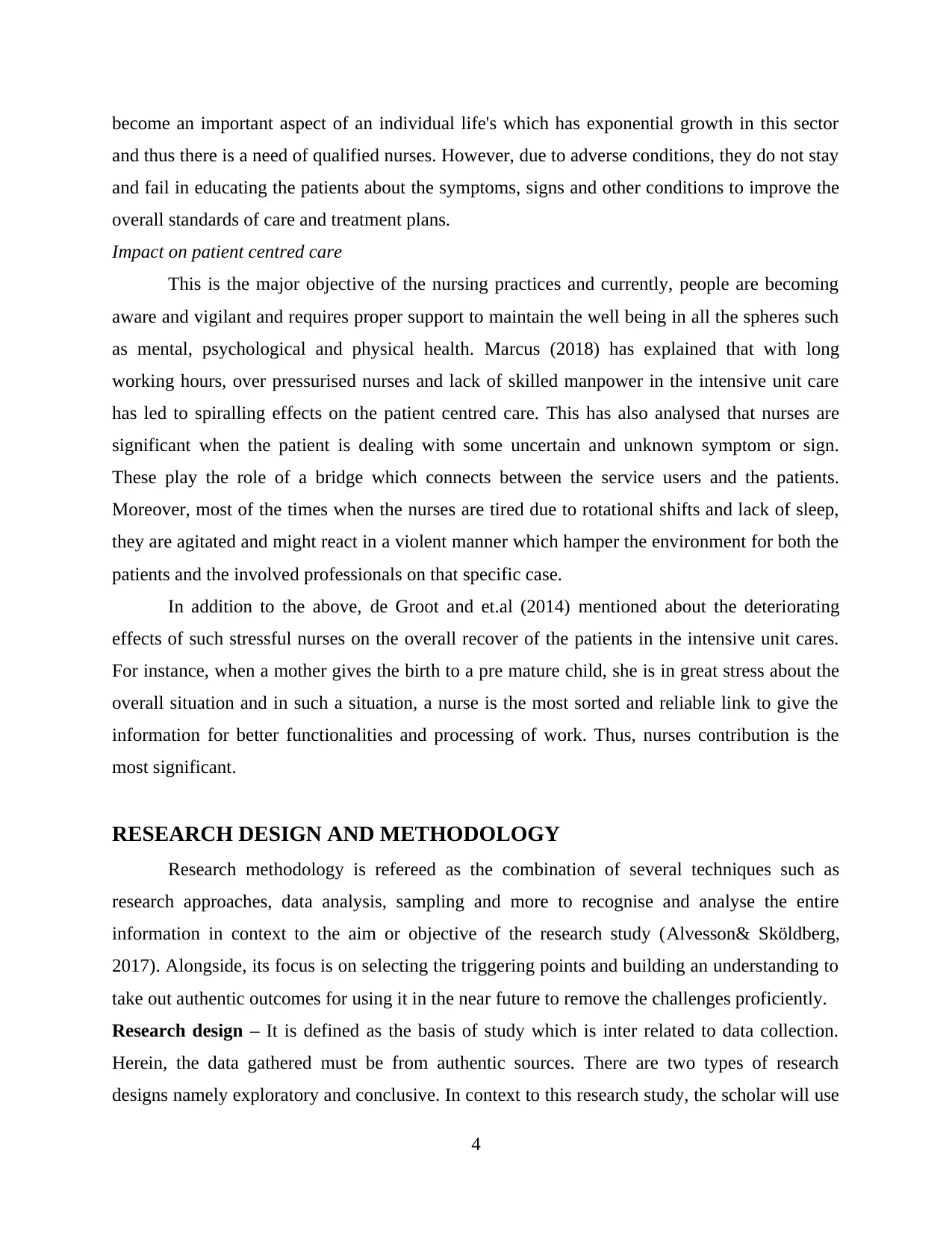
become an important aspect of an individual life's which has exponential growth in this sector
and thus there is a need of qualified nurses. However, due to adverse conditions, they do not stay
and fail in educating the patients about the symptoms, signs and other conditions to improve the
overall standards of care and treatment plans.
Impact on patient centred care
This is the major objective of the nursing practices and currently, people are becoming
aware and vigilant and requires proper support to maintain the well being in all the spheres such
as mental, psychological and physical health. Marcus (2018) has explained that with long
working hours, over pressurised nurses and lack of skilled manpower in the intensive unit care
has led to spiralling effects on the patient centred care. This has also analysed that nurses are
significant when the patient is dealing with some uncertain and unknown symptom or sign.
These play the role of a bridge which connects between the service users and the patients.
Moreover, most of the times when the nurses are tired due to rotational shifts and lack of sleep,
they are agitated and might react in a violent manner which hamper the environment for both the
patients and the involved professionals on that specific case.
In addition to the above, de Groot and et.al (2014) mentioned about the deteriorating
effects of such stressful nurses on the overall recover of the patients in the intensive unit cares.
For instance, when a mother gives the birth to a pre mature child, she is in great stress about the
overall situation and in such a situation, a nurse is the most sorted and reliable link to give the
information for better functionalities and processing of work. Thus, nurses contribution is the
most significant.
RESEARCH DESIGN AND METHODOLOGY
Research methodology is refereed as the combination of several techniques such as
research approaches, data analysis, sampling and more to recognise and analyse the entire
information in context to the aim or objective of the research study (Alvesson& Sköldberg,
2017). Alongside, its focus is on selecting the triggering points and building an understanding to
take out authentic outcomes for using it in the near future to remove the challenges proficiently.
Research design – It is defined as the basis of study which is inter related to data collection.
Herein, the data gathered must be from authentic sources. There are two types of research
designs namely exploratory and conclusive. In context to this research study, the scholar will use
4
and thus there is a need of qualified nurses. However, due to adverse conditions, they do not stay
and fail in educating the patients about the symptoms, signs and other conditions to improve the
overall standards of care and treatment plans.
Impact on patient centred care
This is the major objective of the nursing practices and currently, people are becoming
aware and vigilant and requires proper support to maintain the well being in all the spheres such
as mental, psychological and physical health. Marcus (2018) has explained that with long
working hours, over pressurised nurses and lack of skilled manpower in the intensive unit care
has led to spiralling effects on the patient centred care. This has also analysed that nurses are
significant when the patient is dealing with some uncertain and unknown symptom or sign.
These play the role of a bridge which connects between the service users and the patients.
Moreover, most of the times when the nurses are tired due to rotational shifts and lack of sleep,
they are agitated and might react in a violent manner which hamper the environment for both the
patients and the involved professionals on that specific case.
In addition to the above, de Groot and et.al (2014) mentioned about the deteriorating
effects of such stressful nurses on the overall recover of the patients in the intensive unit cares.
For instance, when a mother gives the birth to a pre mature child, she is in great stress about the
overall situation and in such a situation, a nurse is the most sorted and reliable link to give the
information for better functionalities and processing of work. Thus, nurses contribution is the
most significant.
RESEARCH DESIGN AND METHODOLOGY
Research methodology is refereed as the combination of several techniques such as
research approaches, data analysis, sampling and more to recognise and analyse the entire
information in context to the aim or objective of the research study (Alvesson& Sköldberg,
2017). Alongside, its focus is on selecting the triggering points and building an understanding to
take out authentic outcomes for using it in the near future to remove the challenges proficiently.
Research design – It is defined as the basis of study which is inter related to data collection.
Herein, the data gathered must be from authentic sources. There are two types of research
designs namely exploratory and conclusive. In context to this research study, the scholar will use
4
⊘ This is a preview!⊘
Do you want full access?
Subscribe today to unlock all pages.

Trusted by 1+ million students worldwide
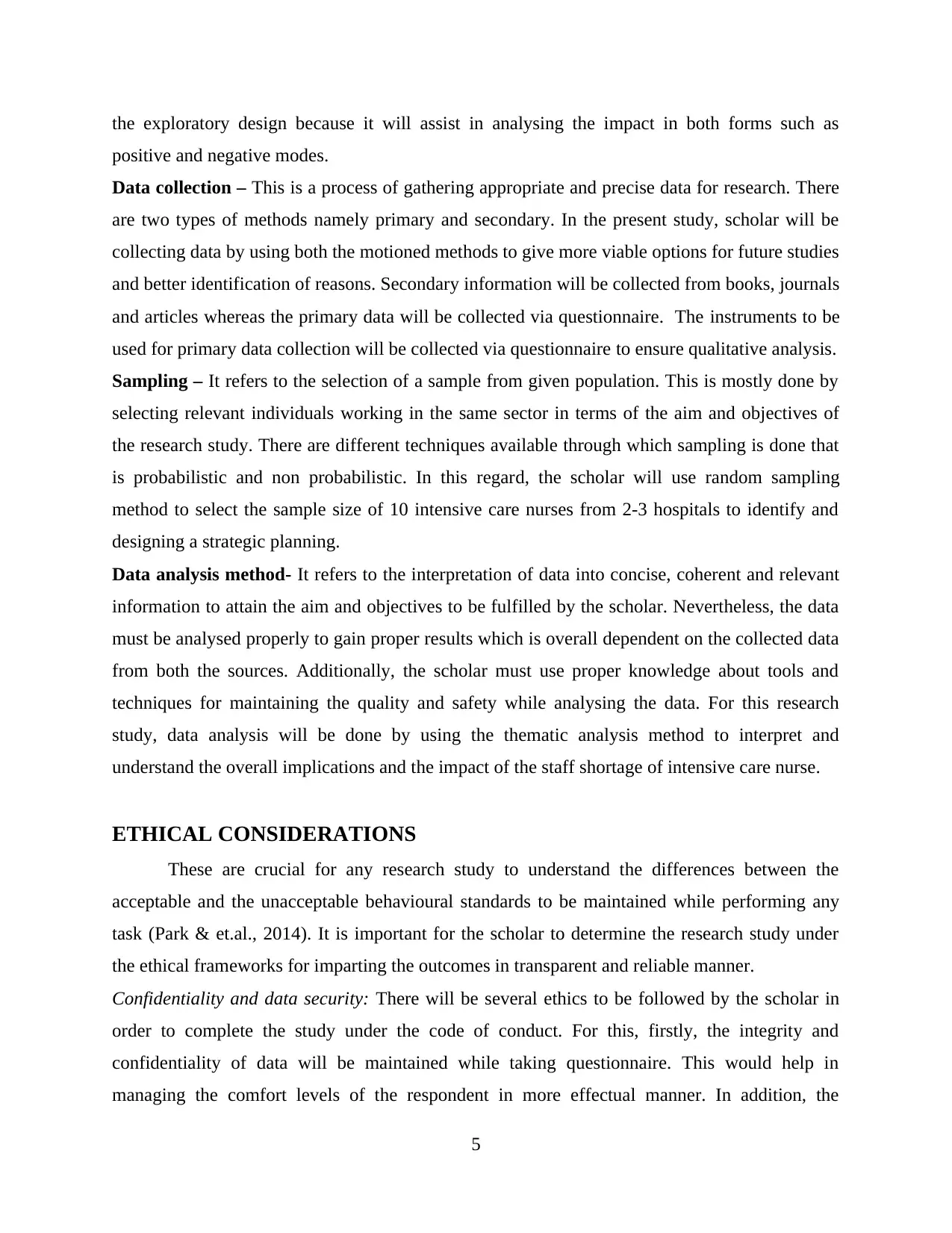
the exploratory design because it will assist in analysing the impact in both forms such as
positive and negative modes.
Data collection – This is a process of gathering appropriate and precise data for research. There
are two types of methods namely primary and secondary. In the present study, scholar will be
collecting data by using both the motioned methods to give more viable options for future studies
and better identification of reasons. Secondary information will be collected from books, journals
and articles whereas the primary data will be collected via questionnaire. The instruments to be
used for primary data collection will be collected via questionnaire to ensure qualitative analysis.
Sampling – It refers to the selection of a sample from given population. This is mostly done by
selecting relevant individuals working in the same sector in terms of the aim and objectives of
the research study. There are different techniques available through which sampling is done that
is probabilistic and non probabilistic. In this regard, the scholar will use random sampling
method to select the sample size of 10 intensive care nurses from 2-3 hospitals to identify and
designing a strategic planning.
Data analysis method- It refers to the interpretation of data into concise, coherent and relevant
information to attain the aim and objectives to be fulfilled by the scholar. Nevertheless, the data
must be analysed properly to gain proper results which is overall dependent on the collected data
from both the sources. Additionally, the scholar must use proper knowledge about tools and
techniques for maintaining the quality and safety while analysing the data. For this research
study, data analysis will be done by using the thematic analysis method to interpret and
understand the overall implications and the impact of the staff shortage of intensive care nurse.
ETHICAL CONSIDERATIONS
These are crucial for any research study to understand the differences between the
acceptable and the unacceptable behavioural standards to be maintained while performing any
task (Park & et.al., 2014). It is important for the scholar to determine the research study under
the ethical frameworks for imparting the outcomes in transparent and reliable manner.
Confidentiality and data security: There will be several ethics to be followed by the scholar in
order to complete the study under the code of conduct. For this, firstly, the integrity and
confidentiality of data will be maintained while taking questionnaire. This would help in
managing the comfort levels of the respondent in more effectual manner. In addition, the
5
positive and negative modes.
Data collection – This is a process of gathering appropriate and precise data for research. There
are two types of methods namely primary and secondary. In the present study, scholar will be
collecting data by using both the motioned methods to give more viable options for future studies
and better identification of reasons. Secondary information will be collected from books, journals
and articles whereas the primary data will be collected via questionnaire. The instruments to be
used for primary data collection will be collected via questionnaire to ensure qualitative analysis.
Sampling – It refers to the selection of a sample from given population. This is mostly done by
selecting relevant individuals working in the same sector in terms of the aim and objectives of
the research study. There are different techniques available through which sampling is done that
is probabilistic and non probabilistic. In this regard, the scholar will use random sampling
method to select the sample size of 10 intensive care nurses from 2-3 hospitals to identify and
designing a strategic planning.
Data analysis method- It refers to the interpretation of data into concise, coherent and relevant
information to attain the aim and objectives to be fulfilled by the scholar. Nevertheless, the data
must be analysed properly to gain proper results which is overall dependent on the collected data
from both the sources. Additionally, the scholar must use proper knowledge about tools and
techniques for maintaining the quality and safety while analysing the data. For this research
study, data analysis will be done by using the thematic analysis method to interpret and
understand the overall implications and the impact of the staff shortage of intensive care nurse.
ETHICAL CONSIDERATIONS
These are crucial for any research study to understand the differences between the
acceptable and the unacceptable behavioural standards to be maintained while performing any
task (Park & et.al., 2014). It is important for the scholar to determine the research study under
the ethical frameworks for imparting the outcomes in transparent and reliable manner.
Confidentiality and data security: There will be several ethics to be followed by the scholar in
order to complete the study under the code of conduct. For this, firstly, the integrity and
confidentiality of data will be maintained while taking questionnaire. This would help in
managing the comfort levels of the respondent in more effectual manner. In addition, the
5
Paraphrase This Document
Need a fresh take? Get an instant paraphrase of this document with our AI Paraphraser
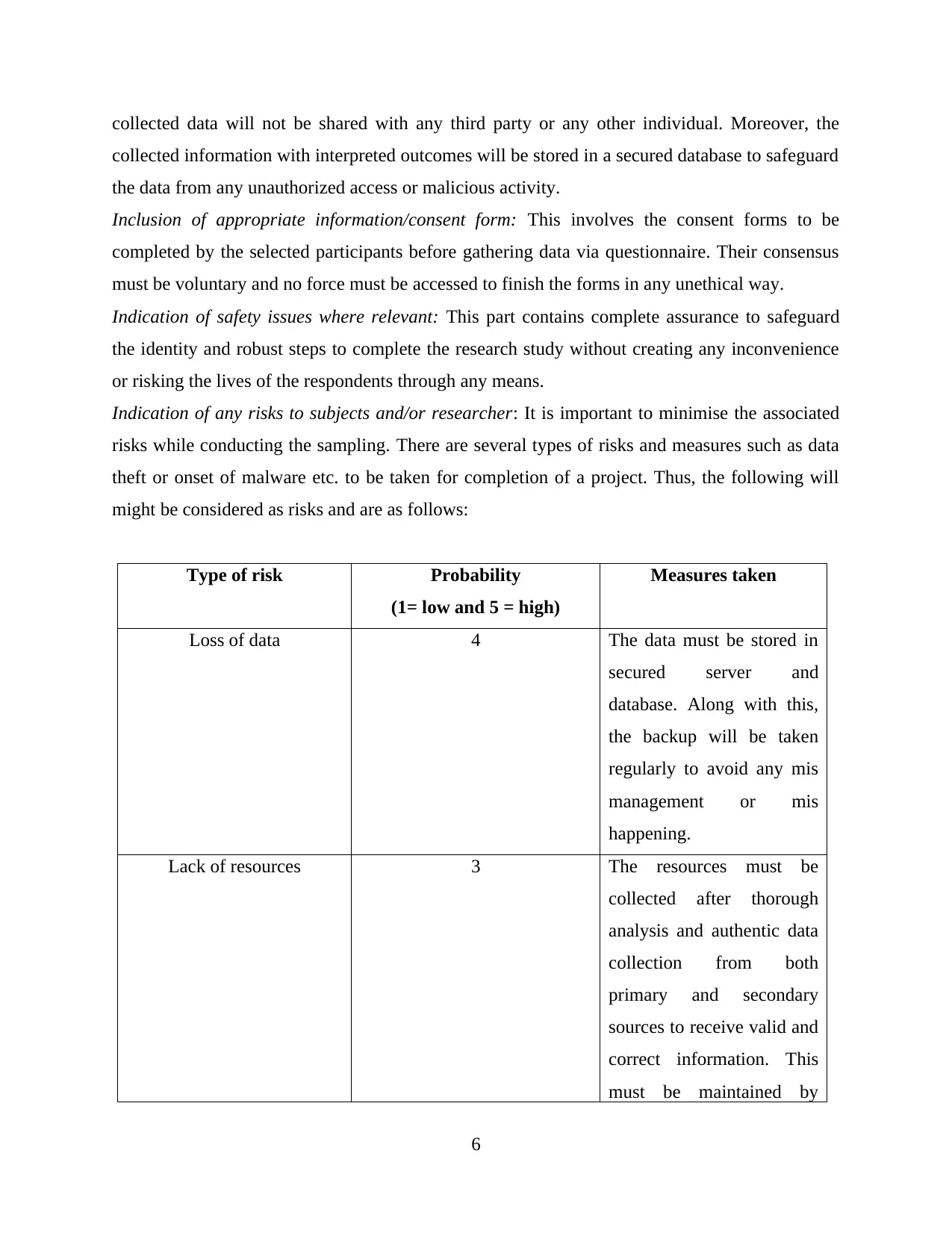
collected data will not be shared with any third party or any other individual. Moreover, the
collected information with interpreted outcomes will be stored in a secured database to safeguard
the data from any unauthorized access or malicious activity.
Inclusion of appropriate information/consent form: This involves the consent forms to be
completed by the selected participants before gathering data via questionnaire. Their consensus
must be voluntary and no force must be accessed to finish the forms in any unethical way.
Indication of safety issues where relevant: This part contains complete assurance to safeguard
the identity and robust steps to complete the research study without creating any inconvenience
or risking the lives of the respondents through any means.
Indication of any risks to subjects and/or researcher: It is important to minimise the associated
risks while conducting the sampling. There are several types of risks and measures such as data
theft or onset of malware etc. to be taken for completion of a project. Thus, the following will
might be considered as risks and are as follows:
Type of risk Probability
(1= low and 5 = high)
Measures taken
Loss of data 4 The data must be stored in
secured server and
database. Along with this,
the backup will be taken
regularly to avoid any mis
management or mis
happening.
Lack of resources 3 The resources must be
collected after thorough
analysis and authentic data
collection from both
primary and secondary
sources to receive valid and
correct information. This
must be maintained by
6
collected information with interpreted outcomes will be stored in a secured database to safeguard
the data from any unauthorized access or malicious activity.
Inclusion of appropriate information/consent form: This involves the consent forms to be
completed by the selected participants before gathering data via questionnaire. Their consensus
must be voluntary and no force must be accessed to finish the forms in any unethical way.
Indication of safety issues where relevant: This part contains complete assurance to safeguard
the identity and robust steps to complete the research study without creating any inconvenience
or risking the lives of the respondents through any means.
Indication of any risks to subjects and/or researcher: It is important to minimise the associated
risks while conducting the sampling. There are several types of risks and measures such as data
theft or onset of malware etc. to be taken for completion of a project. Thus, the following will
might be considered as risks and are as follows:
Type of risk Probability
(1= low and 5 = high)
Measures taken
Loss of data 4 The data must be stored in
secured server and
database. Along with this,
the backup will be taken
regularly to avoid any mis
management or mis
happening.
Lack of resources 3 The resources must be
collected after thorough
analysis and authentic data
collection from both
primary and secondary
sources to receive valid and
correct information. This
must be maintained by
6
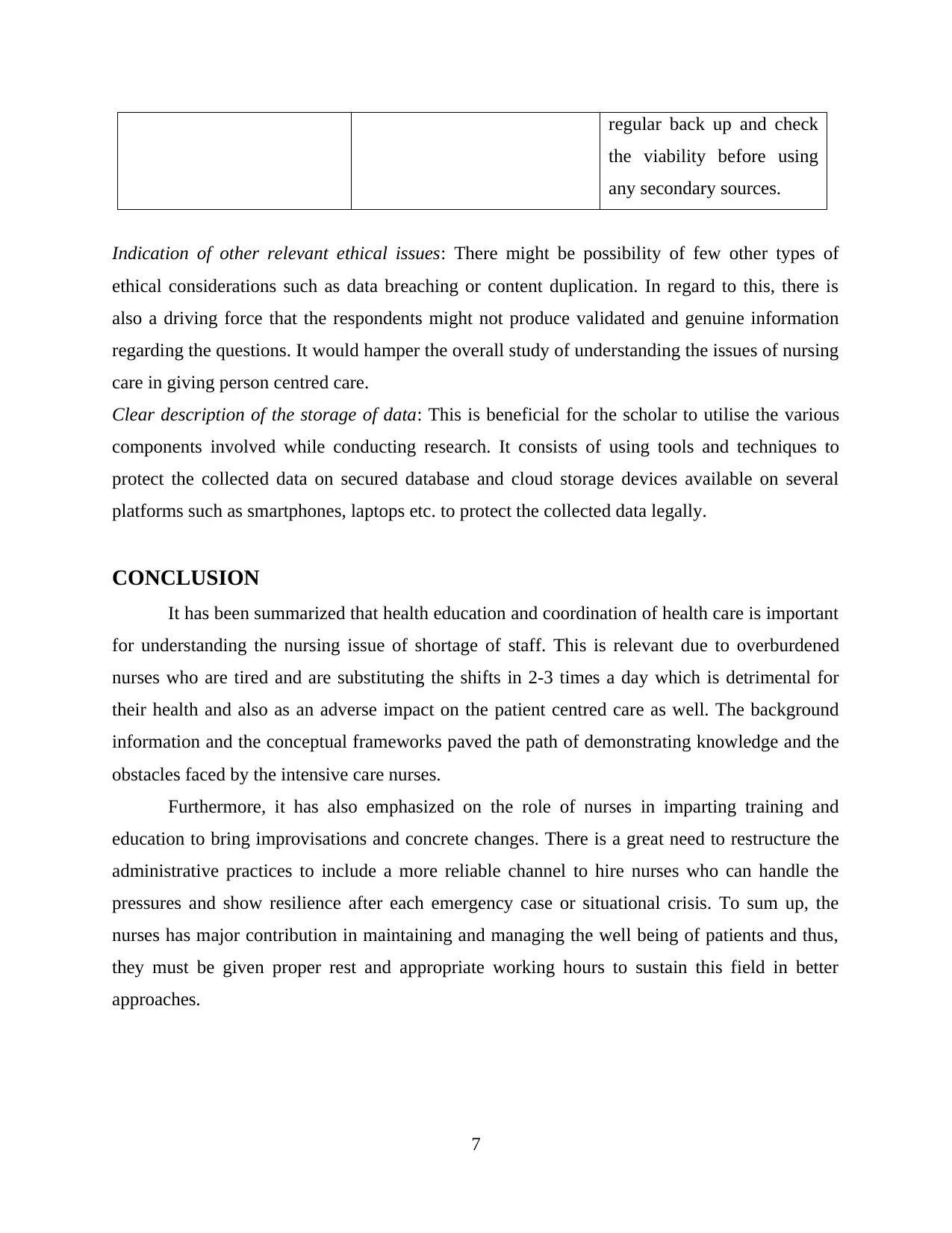
regular back up and check
the viability before using
any secondary sources.
Indication of other relevant ethical issues: There might be possibility of few other types of
ethical considerations such as data breaching or content duplication. In regard to this, there is
also a driving force that the respondents might not produce validated and genuine information
regarding the questions. It would hamper the overall study of understanding the issues of nursing
care in giving person centred care.
Clear description of the storage of data: This is beneficial for the scholar to utilise the various
components involved while conducting research. It consists of using tools and techniques to
protect the collected data on secured database and cloud storage devices available on several
platforms such as smartphones, laptops etc. to protect the collected data legally.
CONCLUSION
It has been summarized that health education and coordination of health care is important
for understanding the nursing issue of shortage of staff. This is relevant due to overburdened
nurses who are tired and are substituting the shifts in 2-3 times a day which is detrimental for
their health and also as an adverse impact on the patient centred care as well. The background
information and the conceptual frameworks paved the path of demonstrating knowledge and the
obstacles faced by the intensive care nurses.
Furthermore, it has also emphasized on the role of nurses in imparting training and
education to bring improvisations and concrete changes. There is a great need to restructure the
administrative practices to include a more reliable channel to hire nurses who can handle the
pressures and show resilience after each emergency case or situational crisis. To sum up, the
nurses has major contribution in maintaining and managing the well being of patients and thus,
they must be given proper rest and appropriate working hours to sustain this field in better
approaches.
7
the viability before using
any secondary sources.
Indication of other relevant ethical issues: There might be possibility of few other types of
ethical considerations such as data breaching or content duplication. In regard to this, there is
also a driving force that the respondents might not produce validated and genuine information
regarding the questions. It would hamper the overall study of understanding the issues of nursing
care in giving person centred care.
Clear description of the storage of data: This is beneficial for the scholar to utilise the various
components involved while conducting research. It consists of using tools and techniques to
protect the collected data on secured database and cloud storage devices available on several
platforms such as smartphones, laptops etc. to protect the collected data legally.
CONCLUSION
It has been summarized that health education and coordination of health care is important
for understanding the nursing issue of shortage of staff. This is relevant due to overburdened
nurses who are tired and are substituting the shifts in 2-3 times a day which is detrimental for
their health and also as an adverse impact on the patient centred care as well. The background
information and the conceptual frameworks paved the path of demonstrating knowledge and the
obstacles faced by the intensive care nurses.
Furthermore, it has also emphasized on the role of nurses in imparting training and
education to bring improvisations and concrete changes. There is a great need to restructure the
administrative practices to include a more reliable channel to hire nurses who can handle the
pressures and show resilience after each emergency case or situational crisis. To sum up, the
nurses has major contribution in maintaining and managing the well being of patients and thus,
they must be given proper rest and appropriate working hours to sustain this field in better
approaches.
7
⊘ This is a preview!⊘
Do you want full access?
Subscribe today to unlock all pages.

Trusted by 1+ million students worldwide
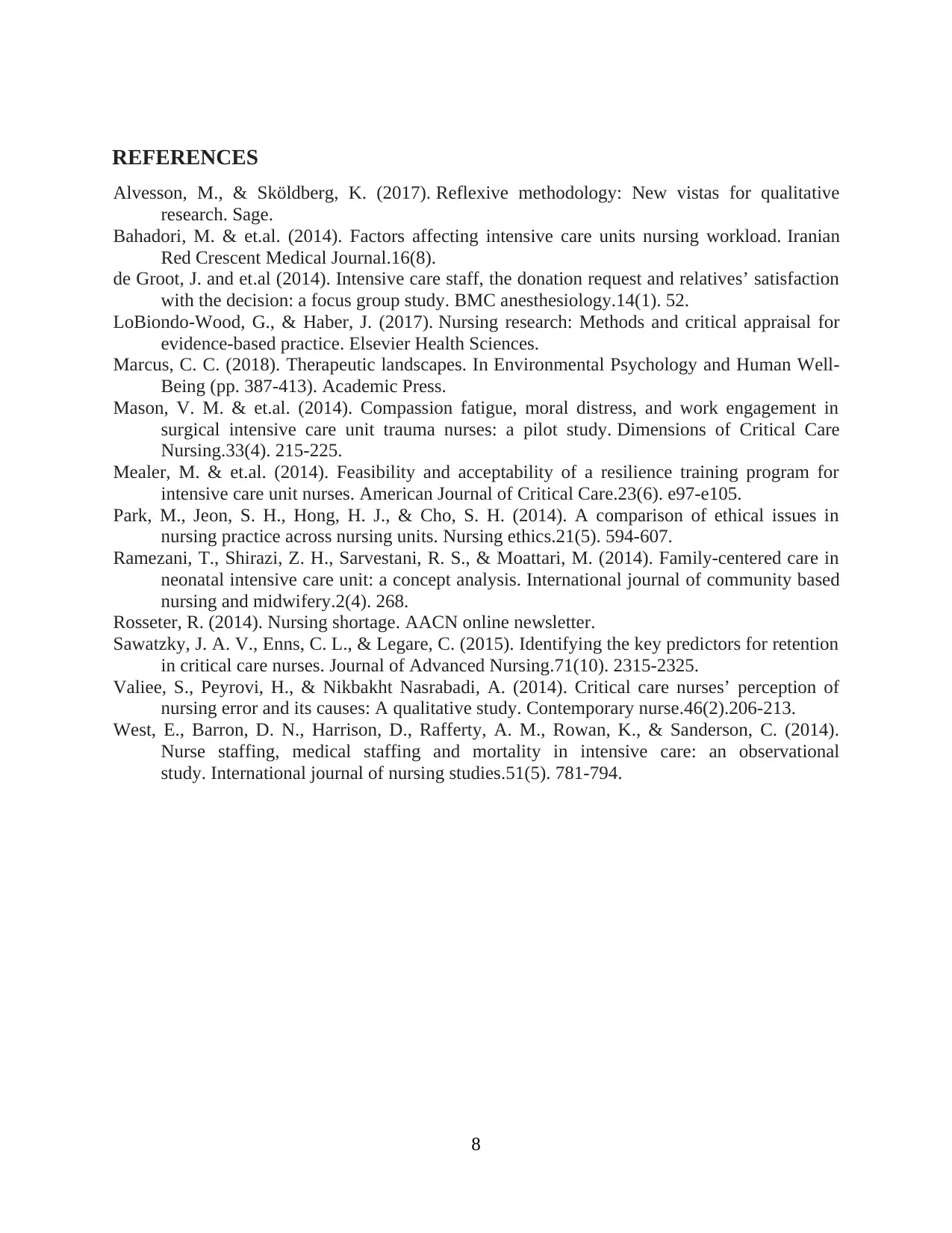
REFERENCES
Alvesson, M., & Sköldberg, K. (2017). Reflexive methodology: New vistas for qualitative
research. Sage.
Bahadori, M. & et.al. (2014). Factors affecting intensive care units nursing workload. Iranian
Red Crescent Medical Journal.16(8).
de Groot, J. and et.al (2014). Intensive care staff, the donation request and relatives’ satisfaction
with the decision: a focus group study. BMC anesthesiology.14(1). 52.
LoBiondo-Wood, G., & Haber, J. (2017). Nursing research: Methods and critical appraisal for
evidence-based practice. Elsevier Health Sciences.
Marcus, C. C. (2018). Therapeutic landscapes. In Environmental Psychology and Human Well-
Being (pp. 387-413). Academic Press.
Mason, V. M. & et.al. (2014). Compassion fatigue, moral distress, and work engagement in
surgical intensive care unit trauma nurses: a pilot study. Dimensions of Critical Care
Nursing.33(4). 215-225.
Mealer, M. & et.al. (2014). Feasibility and acceptability of a resilience training program for
intensive care unit nurses. American Journal of Critical Care.23(6). e97-e105.
Park, M., Jeon, S. H., Hong, H. J., & Cho, S. H. (2014). A comparison of ethical issues in
nursing practice across nursing units. Nursing ethics.21(5). 594-607.
Ramezani, T., Shirazi, Z. H., Sarvestani, R. S., & Moattari, M. (2014). Family-centered care in
neonatal intensive care unit: a concept analysis. International journal of community based
nursing and midwifery.2(4). 268.
Rosseter, R. (2014). Nursing shortage. AACN online newsletter.
Sawatzky, J. A. V., Enns, C. L., & Legare, C. (2015). Identifying the key predictors for retention
in critical care nurses. Journal of Advanced Nursing.71(10). 2315-2325.
Valiee, S., Peyrovi, H., & Nikbakht Nasrabadi, A. (2014). Critical care nurses’ perception of
nursing error and its causes: A qualitative study. Contemporary nurse.46(2).206-213.
West, E., Barron, D. N., Harrison, D., Rafferty, A. M., Rowan, K., & Sanderson, C. (2014).
Nurse staffing, medical staffing and mortality in intensive care: an observational
study. International journal of nursing studies.51(5). 781-794.
8
Alvesson, M., & Sköldberg, K. (2017). Reflexive methodology: New vistas for qualitative
research. Sage.
Bahadori, M. & et.al. (2014). Factors affecting intensive care units nursing workload. Iranian
Red Crescent Medical Journal.16(8).
de Groot, J. and et.al (2014). Intensive care staff, the donation request and relatives’ satisfaction
with the decision: a focus group study. BMC anesthesiology.14(1). 52.
LoBiondo-Wood, G., & Haber, J. (2017). Nursing research: Methods and critical appraisal for
evidence-based practice. Elsevier Health Sciences.
Marcus, C. C. (2018). Therapeutic landscapes. In Environmental Psychology and Human Well-
Being (pp. 387-413). Academic Press.
Mason, V. M. & et.al. (2014). Compassion fatigue, moral distress, and work engagement in
surgical intensive care unit trauma nurses: a pilot study. Dimensions of Critical Care
Nursing.33(4). 215-225.
Mealer, M. & et.al. (2014). Feasibility and acceptability of a resilience training program for
intensive care unit nurses. American Journal of Critical Care.23(6). e97-e105.
Park, M., Jeon, S. H., Hong, H. J., & Cho, S. H. (2014). A comparison of ethical issues in
nursing practice across nursing units. Nursing ethics.21(5). 594-607.
Ramezani, T., Shirazi, Z. H., Sarvestani, R. S., & Moattari, M. (2014). Family-centered care in
neonatal intensive care unit: a concept analysis. International journal of community based
nursing and midwifery.2(4). 268.
Rosseter, R. (2014). Nursing shortage. AACN online newsletter.
Sawatzky, J. A. V., Enns, C. L., & Legare, C. (2015). Identifying the key predictors for retention
in critical care nurses. Journal of Advanced Nursing.71(10). 2315-2325.
Valiee, S., Peyrovi, H., & Nikbakht Nasrabadi, A. (2014). Critical care nurses’ perception of
nursing error and its causes: A qualitative study. Contemporary nurse.46(2).206-213.
West, E., Barron, D. N., Harrison, D., Rafferty, A. M., Rowan, K., & Sanderson, C. (2014).
Nurse staffing, medical staffing and mortality in intensive care: an observational
study. International journal of nursing studies.51(5). 781-794.
8
Paraphrase This Document
Need a fresh take? Get an instant paraphrase of this document with our AI Paraphraser

9

10
⊘ This is a preview!⊘
Do you want full access?
Subscribe today to unlock all pages.

Trusted by 1+ million students worldwide
1 out of 14
Related Documents
Your All-in-One AI-Powered Toolkit for Academic Success.
+13062052269
info@desklib.com
Available 24*7 on WhatsApp / Email
![[object Object]](/_next/static/media/star-bottom.7253800d.svg)
Unlock your academic potential
Copyright © 2020–2025 A2Z Services. All Rights Reserved. Developed and managed by ZUCOL.





